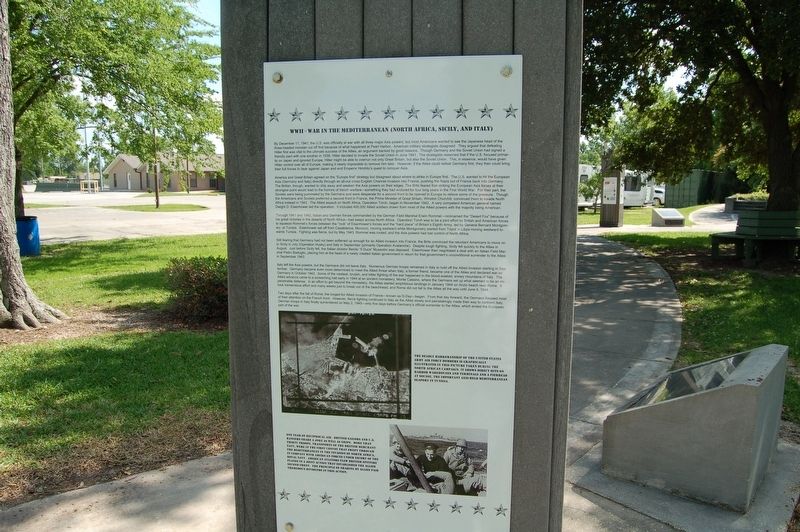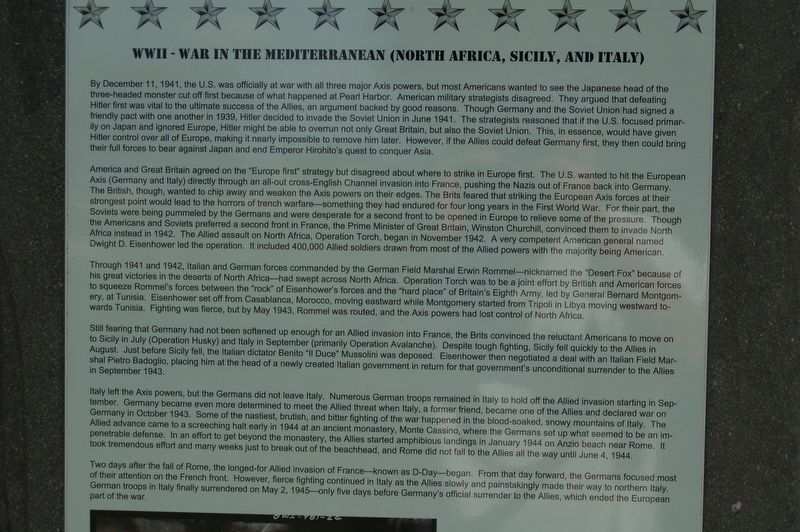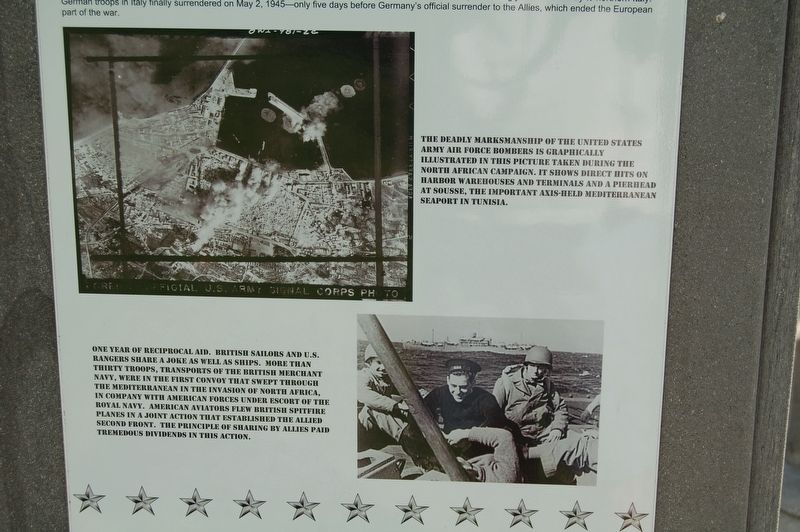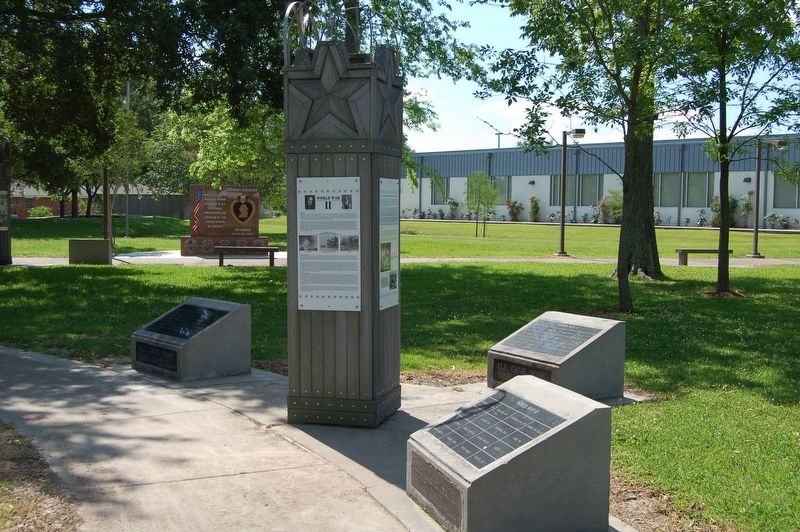WWII - War In The Mediterranean
(North Africa, Sicily, and Italy)
By December 11, 1941, the U.S. was officially at war with all three major Axis powers, but most Americans wanted to see the Japanese head of the three-headed monster cut off first because of what happened at Pearl Harbor. American military strategists disagreed. They argued that defeating Hitler first was vital to the ultimate success of the Allies, an argument backed by good reasons. Though Germany and the Soviet Union had signed a friendly pact with one another in 1939, Hitler decided to invade the Soviet Union in June 1941. The strategists reasoned that if the U.S. focused primarily on Japan and ignored Europe, Hitler might be able to overrun not only Great Britain, but also the Soviet Union. This, in essence, would have given Hitler control over all of Europe, making it nearly impossible to remove him later. However, if the Allies could defeat Germany first, they then could bring their full forces to bear against Japan and end Emperor Hirohito's quest to conquer Asia.
America and Great Britain agreed on the “Europe first" strategy but disagreed about where to strike in Europe first. The U.S. wanted to hit the European Axis (Germany and Italy) directly through an all-out cross-English Channel invasion into France, pushing the Nazis out of France back into Germany. The British, though, wanted to chip away and weaken the
Axis powers on their edges. The Brits feared that striking the European Axis forces at their strongest point would lead to the horrors of trench warfare—something they had endured for four long years in the First World War. For their part, the Soviets were being pummeled by the Germans and were desperate for a second front to be opened in Europe to relieve some of the pressure. Though the Americans and Soviets preferred a second front in France, the Prime Minister of Great Britain, Winston Churchill, convinced them to invade North Africa instead in 1942. The Allied assault on North Africa, Operation Torch, began in November 1942. A very competent American general named Dwight D. Eisenhower led the operation. It included 400,000 Allied soldiers drawn from most of the Allied powers with the majority being American.Through 1941 and 1942, Italian and German forces commanded by the German Field Marshal Erwin Rommel-nicknamed the "Desert Fox" because of his great victories in the deserts of North Africa—had swept across North Africa. Operation Torch was to be a joint effort by British and American forces to squeeze Rommel's forces between the "rock" of Eisenhower's forces and the "hard place" of Britain's Eighth Army, led by General Bernard Montgomery, at Tunisia. Eisenhower set off from Casablanca, Morocco, moving eastward while Montgomery started from Tripoli in Libya
moving westward to- wards Tunisia. Fighting was fierce, but by May 1943, Rommel was routed, and the Axis powers had lost control of North Africa.Still fearing that Germany had not been softened up enough for an Allied invasion into France, the Brits convinced the reluctant Americans to move on to Sicily in July (Operation Husky) and Italy in September (primarily Operation Avalanche). Despite tough fighting, Sicily fell quickly to the Allies in August. Just before Sicily fell, the Italian dictator Benito “II Duce” Mussolini was deposed. Eisenhower then negotiated a deal with an Italian Field Marshal Pietro Badoglio, placing him at the head of a newly created Italian government in return for that government's unconditional surrender to the Allies in September 1943.
Italy left the Axis powers, but the Germans did not leave Italy. Numerous German troops remained in Italy to hold off the Allied invasion starting in September. Germany became even more determined to meet the Allied threat when Italy, a former friend, became one of the Allies and declared war on Germany in October 1943. Some of the nastiest, brutish, and bitter fighting of the war happened in the blood-soaked, snowy mountains of Italy. The Allied advance came to a screeching halt early in 1944 at an ancient monastery, Monte Cassino, where the Germans set up what seemed to be an impenetrable defense.
In an effort to get beyond the monastery, the Allies started amphibious landings in January 1944 on Anzio beach near Rome. It took tremendous effort and many weeks just to break out of the beachhead, and Rome did not fall to the Allies all the way until June 4, 1944. Two days after the fall of Rome, the longed-for Allied invasion of France-known as D-Day-began. From that day forward, the Germans focused most of their attention on the French front. However, fierce fighting continued in Italy as the Allies slowly and painstakingly made their way to northern Italy. German troops in Italy finally surrendered on May 2, 1945-only five days before Germany's official surrender to the Allies, which ended the European part of the war.
Topics and series. This memorial is listed in this topic list: War, World II. In addition, it is included in the Former U.S. Presidents: #34 Dwight D. Eisenhower series list.
Location. 30° 13.708′ N, 90° 54.782′ W. Marker is in Gonzales, Louisiana, in Ascension Parish. Memorial can be reached from South Irma Boulevard, 0.3 miles north of East Worthey Street, on the right when traveling north. Touch for map. Marker is in this post office area: Gonzales LA 70737, United States of America. Touch for directions.
Other nearby markers. At least 8 other markers are within walking distance of this marker. WWII - War In Europe (here, next to this marker); World War II (here, next to this marker); WWII - War In The Pacific
Credits. This page was last revised on April 1, 2018. It was originally submitted on April 1, 2018, by Cajun Scrambler of Assumption, Louisiana. This page has been viewed 230 times since then and 44 times this year. Photos: 1, 2, 3, 4. submitted on April 1, 2018.



